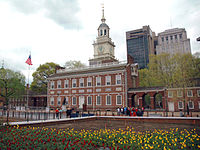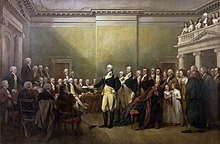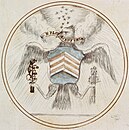Congress of the Confederation
| |||||||||||||||||||||||||||||||||||||||||||||||||||||||||||||||||||||||||||||||||||||||||||||||||||||||||||||||||||||||||||||||||||||||||||||||||||||||||||||||||||||
Read other articles:

Yang Berbahagia Tan Sri Dato' Seri DiRajaRamli Ngah TalibPSM SPSA SPCM AMN PCM JPراملي ڠه طالب Ketua Dewan Rakyat Ke- 7Masa jabatan22 November 2004 – 13 Februari 2008Penguasa monarkiTuanku Syed SirajuddinSultan Mizan Zainal AbidinWakilLim Si ChengYusof YacobPendahuluMohamed Zahir IsmailPenggantiPandikar Amin MuliaDaerah pemilihanPasir SalakMenteri Besar PerakMasa jabatan1 Maret 1983 – 2 Desember 1999Penguasa monarkiSultan IdrisSultan Azlan Muhibuddin ShahPendahul…

Italian billionaire businessman Piero FerrariFerrari in 2012BornPiero Lardi (1945-05-22) 22 May 1945 (age 78)[1]Castelvetro di Modena, Kingdom of ItalyOccupationBusinessmanTitleVice chairman, Ferrari Chairman, HPE COXABoard member ofFerrari Ferretti GroupSpouseRomina GingașuChildren1ParentsEnzo Ferrari (father)Lina Lardi (mother)RelativesDino Ferrari (half-brother) Piero Ferrari (born Piero Lardi, then Piero Lardi Ferrari; 22 May 1945[1]) is an Italian billionaire busi…

此条目序言章节没有充分总结全文内容要点。 (2019年3月21日)请考虑扩充序言,清晰概述条目所有重點。请在条目的讨论页讨论此问题。 哈萨克斯坦總統哈薩克總統旗現任Қасым-Жомарт Кемелұлы Тоқаев卡瑟姆若马尔特·托卡耶夫自2019年3月20日在任任期7年首任努尔苏丹·纳扎尔巴耶夫设立1990年4月24日(哈薩克蘇維埃社會主義共和國總統) 哈萨克斯坦 哈萨克斯坦政府與�…

مارستون مورس (بالإنجليزية: Harold Calvin Marston Morse) معلومات شخصية اسم الولادة (بالإنجليزية: Harold Calvin Marston Morse) الميلاد 24 مارس 1892 [1] ووترفيل الوفاة 22 يونيو 1977 (85 سنة) [1] برينستون مواطنة الولايات المتحدة عضو في أكاديمية هايدلبرغ للعلوم والعلوم الإنسان…

Village in Kerala, IndiaThimiri ThripurivillageThimiriLocation in Kerala, IndiaCoordinates: 12°12′0″N 75°23′10″E / 12.20000°N 75.38611°E / 12.20000; 75.38611Country IndiaStateKeralaDistrictKannurArea • Total47.3 km2 (18.3 sq mi)Population (2011) • Total18,044 • Density380/km2 (990/sq mi)Languages • OfficialMalayalam, EnglishTime zoneUTC+5:30 (IST)PIN670581ISO 3166 codeIN-KLVehicle re…

Rantai Komando Satuan Serdadu Komandan Regu 8–13 Komandan regu Peleton 26–55 Komandan peleton Kompi 80–225 Kapten/Mayor Batalyon 300–1,300 (Letnan) Kolonel Resimen/Brigade 3,000–5,000 Letnan Kolonel / (Brigadir Jenderal) Divisi 10,000–15,000 Mayor Jenderal Korps 20,000–45,000 Letnan Jenderal Tentara darat medan 80,000–200,000 Jenderal Kelompok tentara 400,000–1,000,000 Jenderal Besar Daerah militer 1,000,000–3,000,000 Jenderal Besar Tentara mandala 3,000,000–10,000,000 Jend…

Parliamentary constituency in the United Kingdom PutneyBorough constituencyfor the House of CommonsBoundary of Putney in Greater LondonCountyGreater LondonElectorate62,153 (December 2010)[1]Current constituencyCreated1918; 106 years ago (1918)Member of ParliamentFleur Anderson (Labour)SeatsOneCreated fromWandsworth (abolished, divided into four) Putney is a constituency in Greater London created in 1918 and represented in the House of Commons of the UK Parliament since …

The location of Ghana in Africa Part of a series onJews and Judaism Etymology Who is a Jew? Religion God in Judaism (names) Principles of faith Mitzvot (613) Halakha Shabbat Holidays Prayer Tzedakah Land of Israel Brit Bar and bat mitzvah Marriage Bereavement Baal teshuva Philosophy Ethics Kabbalah Customs Rites Synagogue Rabbi Texts Tanakh Torah Nevi'im Ketuvim Talmud Mishnah Gemara Rabbinic Midrash Tosefta Targum Beit Yosef Mishneh Torah Tur Shulchan Aruch Zohar History Gen…

Example of a force dynamics diagram Semantics LinguisticLogical Subfields Computational Lexical (lexis, lexicology) Statistical Structural Topics Analysis Compositionality Context (language use) Prototype theoryForce dynamics Semantic feature Semantic gap Theory of descriptions Analysis Latent Computational Machine-learning Applications Semantic file system Semantic desktop Semantic matching Semantic parsing Semantic similarity Semantic query Semantic WebSemantic wiki Semantics ofprogramming lan…

Alexandru Emanoil FlorescuBorn(1822-01-22)22 January 1822Died1907 (aged 84–85) Alexandru Emanoil Florescu (22 January 1822 – 1907) was a Wallachian and Romanian politician. Florescu came from a boyar family; his father Manolache was a vornic, while his mother was Tinca Faca. He was the younger brother of Ion Emanuel Florescu.[1] Born in Brașov, in the Transylvania region of the Austrian Empire, he left for the Wallachian capital Bucharest, where he attended Saint Sava Colle…

Russian politician In this name that follows Eastern Slavic naming customs, the patronymic is Valerianovich and the family name is Kanayev. You can help expand this article with text translated from the corresponding article in Russian. (February 2024) Click [show] for important translation instructions. Machine translation, like DeepL or Google Translate, is a useful starting point for translations, but translators must revise errors as necessary and confirm that the translation is acc…

Serbia y Montenegro Estación miembro UJRT Final Nacional Evropesma Apariciones 3 Primera aparición 2004 Mejor resultado Final 2º 2004 Semifinal 1º 2004 Peor resultado Final 7º 2005 Semifinal 1° 2004 Enlaces externos Página de Serbia y Montenegro en Eurovision.tv Serbia y Montenegro fue un país balcánico que participó en el Festival de la Canción de Eurovisión en dos ocasiones desde 2004. En ambas obtuvo posiciones dentro del TOP-10 en la final: el segundo puesto del serbio Željko Jo…

هذه المقالة يتيمة إذ تصل إليها مقالات أخرى قليلة جدًا. فضلًا، ساعد بإضافة وصلة إليها في مقالات متعلقة بها. (يونيو 2018) جوزيبي فارفانيللي معلومات شخصية الميلاد 13 فبراير 1915 بِروجَة تاريخ الوفاة سنة 1979 الجنسية إيطاليا (18 يونيو 1946–1979) مملكة إيطاليا (13 فبراير 1915–18 يونيو …

Artikel ini membutuhkan rujukan tambahan agar kualitasnya dapat dipastikan. Mohon bantu kami mengembangkan artikel ini dengan cara menambahkan rujukan ke sumber tepercaya. Pernyataan tak bersumber bisa saja dipertentangkan dan dihapus.Cari sumber: Rosid – berita · surat kabar · buku · cendekiawan · JSTOR Rosid (juga disebut sebagai Rosidae Cronquist dan Rosids) adalah nama botani pada peringkat subkelas berdasarkan International Code of Botanical Nomencla…

1902 dog cart which remains in the ownership of the family of the original purchaser Arrol-Johnston (later known as Arrol-Aster) was an early Scottish manufacturer of automobiles, which operated from 1895 to 1931 and produced the first automobile manufactured in Britain. The company also developed the world's first off-road vehicle for the Egyptian government, and another designed to travel on ice and snow for Ernest Shackleton's Nimrod Expedition to the South Pole. History George Johnston was b…

Жерар Дюкаружфр. Gérard Ducarouge Жерар Дюкаруж (справа)и Айртон Сенна, 1985 Имя при рождении фр. Gérard Henri Louis Ducarouge[1] Дата рождения 23 октября 1941(1941-10-23)[1] Место рождения Volesvres[вд][1] Дата смерти 19 февраля 2015(2015-02-19)[1] (73 года) Место смерти Нёйи-сюр-Сен[1] Страна …

This article needs additional citations for verification. Please help improve this article by adding citations to reliable sources. Unsourced material may be challenged and removed.Find sources: Dr. Kildare Goes Home – news · newspapers · books · scholar · JSTOR (May 2019) (Learn how and when to remove this message) 1940 American filmDr. Kildare Goes HomeLobby cardDirected byHarold S. BucquetWritten byHarry Ruskin (screenplay)Willis Goldbeck (screenplay)M…

Manuel González de Candamo e Iriarte Presiden Junta Pemerintahan Sementara PeruMasa jabatan20 Maret 1895 – 8 September 1895PendahuluAndrés Avelino CáceresPenggantiNicolás de PiérolaPresiden PeruMasa jabatan8 September 1903 – 7 Mei 1904PendahuluEduardo López de RomañaPenggantiSerapio Calderón Informasi pribadiLahir(1841-07-14)14 Juli 1841Lima, PeruMeninggal7 Mei 1904(1904-05-07) (umur 62)Arequipa, PeruKebangsaanPeruPartai politikPartido CivilSuami/istriTeresa Á…

I-45 on a speed trial run off Sasebo, Japan, on 29 December 1943. History Japan NameSubmarine No. 375 BuilderSasebo Naval Arsenal, Sasebo, Japan Laid down15 July 1942 RenamedI-45 on 5 February 1943 Launched6 March 1943 Completed28 December 1943 Commissioned28 December 1943 FateSunk 29 October 1944 Stricken10 March 1945 General characteristics Class and typeType B2 submarine Displacement 2,624 tons surfaced 3,700 tons submerged Length356.5 ft (108.7 m) Beam…

2007 UK local government election Map showing the results of the 2007 Stockport Metropolitan Borough Council elections by ward. Elections to Stockport Metropolitan Borough Council were held on 3 May 2007. One third of the council was up for election. The Liberal Democrats retained overall control of the council with a majority of 9 councillors. The overall turnout was 36.7%. Following the election, the make up of the council was as follows; Party Seats[1] +/- % vo…










